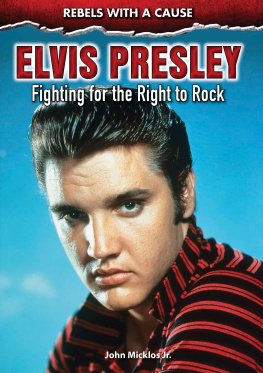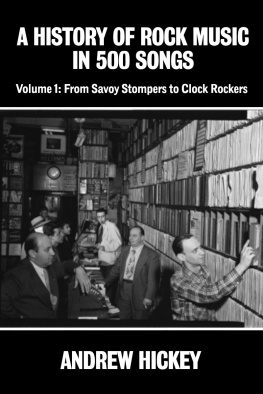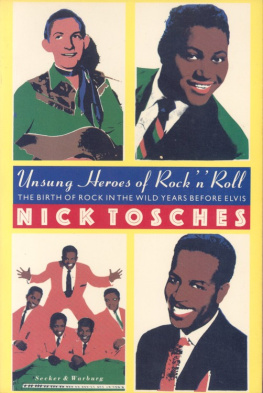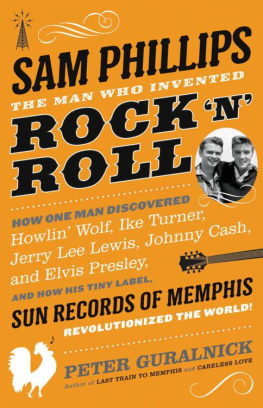
Copyright 2015 by Victoria Micklish Pasmore
All rights reserved. This book, or parts thereof, may not be reproduced in any form without permission.
Published 2015 by Plum Street Publishers, Inc.,
2701 Kavanaugh Boulevard, Suite 202, Little Rock, Arkansas 72205
www.plumstreetpublishers.com
Book and cover design by Liz Lester
(Cover photo of Conway Twitty courtesy of Joni Jenkins Riels; photo of Wanda Jackson copyright Bear Family Records.)
First Edition
Manufactured in the United States of America
10 9 8 7 6 5 4 3 2 1 PB (ISBN 09780-99059715-5)
LIBRARY OF CONGRESS CONTROL NUMBER: 2015947463
The paper used in this publication meets the minimum requirements of the American National Standards for Information SciencesPermanence of Paper for Printed Library Materials, ANSI/NISO Z39.481992.
To my parents,
John and Mari Lou Pasmore,
who saw the birth of rock n roll;
Peter,
who shares my passion for the music;
Elvis Presley,
my first rock n roll love;
and my son David,
who also loves The King
CONTENTS

INTRODUCTION
If the birthplace of Rock n Roll is Memphis, Tennessee, it certainly spent its adolescence in northeast Arkansas. Highway 67 runs 111 miles from Newport, Arkansas, in Jackson County, to the ArkansasMissouri border. It is here that the first rock n rollers staged their early performances and honed their skills, playing the small towns that dotted this two-lane highway. These young musicians and singers performed their music in school gyms and cafeterias, honky-tonks, and clubs that dotted Highway 67 with such colorful names as Bloody Bucket, Silver Moon, Porkys Rooftop, and Bob Kings King of Clubs. They even played on the roof of the Skylark Drive In Theater.
Most of these performers had similar family backgrounds. They were Southern, rural, and poor. They grew up listening to Southern gospel, rhythm and blues, and country music sung by the black and white voices around them. Several of them were mentored by African-American musicians. By combining the sounds of the music they grew up listening to, these performers produced a brand new sound. Young rural teenagers were the first to hear this new music. They looked up, took notice, and became its first fans. In the early days of rock n roll the music was known as rockabilly. This term was originally dismissive, intending to make fun of its Southern roots. As it turned out, this music appealed not only to the young Southerners who created it and those who became its early fans, but to the world as a whole; it created a musical revolution. Later this music would be called rock n roll. Rock n roll not only changed the musical landscape but also influenced popular culture.
Many music historians say that rock n roll was born at Sun Records at Memphis. Originally Memphis Recording Service, it was founded by Sam Phillips in 1952. During this time, many small independent record labels sprang up around the South. Aspiring artists, or those who were just curious to know how they sounded, could walk in the door, pay their money, and record a song. Originally known for his work with African-American blues artists, Phillips recorded such greats as Howlin Wolf, B.B. King, Rufus Thomas, and Junior Parker. He ran a production studio, Sun Studio, as well as a record label, Sun Records.
In the early days of Sun Records, Phillips said, If I could find a white man who had the Negro sound and Negro feel, I could make a million bucks. In 1954, he found that man: Elvis Presley. Working with Phillips, Elvis and his band combined the sounds of country, rhythm and blues, and Southern gospel. Rock n roll was born. Inspired by this new sound and seeking their own musical fortunes, other young musicians such as Johnny Cash, Jerry Lee Lewis, Carl Perkins, and Billy Lee Riley also launched their careers at Sun.
Not too far away, in Trumann, Arkansas, another recording company opened. Arlen Vaden founded Vaden Records, originally a mail-order company offering gospel music. Vaden scouted the musicians who performed along Highway 67 and launched the recording careers of such early rockers as Larry Donn, Joyce Green, Bobby Brown, and Teddy Redell.
The innovative sound created by the early rockabilly artists evolved into rock n roll. This ever-changing musical style is as popular today as it was when it emerged more than sixty years ago. Although rockabilly waned in popularity, it enjoyed a revival in the 1980s. Fans in the United States and particularly in Europe, eager to hear the founding rockabilly artists, gave these artists an encore career when most people their age have retired. It is interesting to note that many of todays rock n roll greats give credit to the early rockabilly artists as their musical inspiration.
In 2009 the Arkansas General Assembly named Highway 67 the Rock n Roll Highway (or Rock n Roll Highway 67) in recognition of its importance in the history of rock n roll music and culture.
Lets take a trip down Highway 67 and meet some of the performers who gave the Rock n Roll Highway its name. Listen carefully, and you may hear the music.
Victoria Micklish Pasmore
May 2015
Elvis Presley

PHOTO BY TERRY WOOD
ELVIS ARON PRESLEY was born in 1935 in a two-room house built by his father, Vernon, in Tupelo, Mississippi. His twin brother, Jesse Garron, died at birth. Elvis was an only child. Because she lost one son, Elviss mother Gladys would be very protective of him.
Music was always important to the Presleys. Elvis and his family sang Southern gospel music in church. He grew up listening to rhythm and blues sung by his African-American neighbors. He listened to country music on the radio. For his twelfth birthday, Gladys took Elvis to Tupelo Hardware and bought him a guitar. Some people say he wanted a bicycle. Others say he wanted a BB gun. But that guitar was probably the most important gift Elvis would ever receive.
Looking for better opportunities, the Presley family moved to the city of Memphis, Tennessee when Elvis was thirteen. Elvis still listened to the music he loved. In Memphis, he had the opportunity to see live concerts by famous gospel quartets. He listened to the rhythm and blues he loved on Beale Street, where he also bought his unusual-looking clothes.
In 1954, he went to Sun Studio and met Sam Phillips. He made his first record, My Happiness, for his mother. A few months later, Phillips called Elvis back to record more songs. Elvis recorded Thats All Right, which combined the sounds of country, gospel, and rhythm and blues, creating a new sound called rock n roll.
In his early career, Elvis performed at numerous clubs along the Rock n Roll Highway. He played at the Newport Armory, Porkys Rooftop, the Silver Moon, Bob Kings King of Clubs, and the Swifton High School gym. He also performed shows in Bono, Jonesboro, Nettleton, Leachville, Helena, Little Rock, and West Memphis.
As a young performer, Elvis scandalized many adults with his wiggling movements on stage, causing many parents to forbid their children from watching or listening. But Elvis became more and more popular and eventually left Sun for RCA Records and became an international star. His early hits include Hound Dog, Heartbreak Hotel, and All Shook Up. Elvis later became a popular movie star and continued to record and tour until his death in 1977 at age forty-two.
Next page










